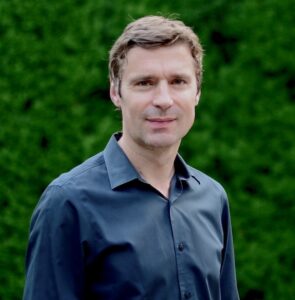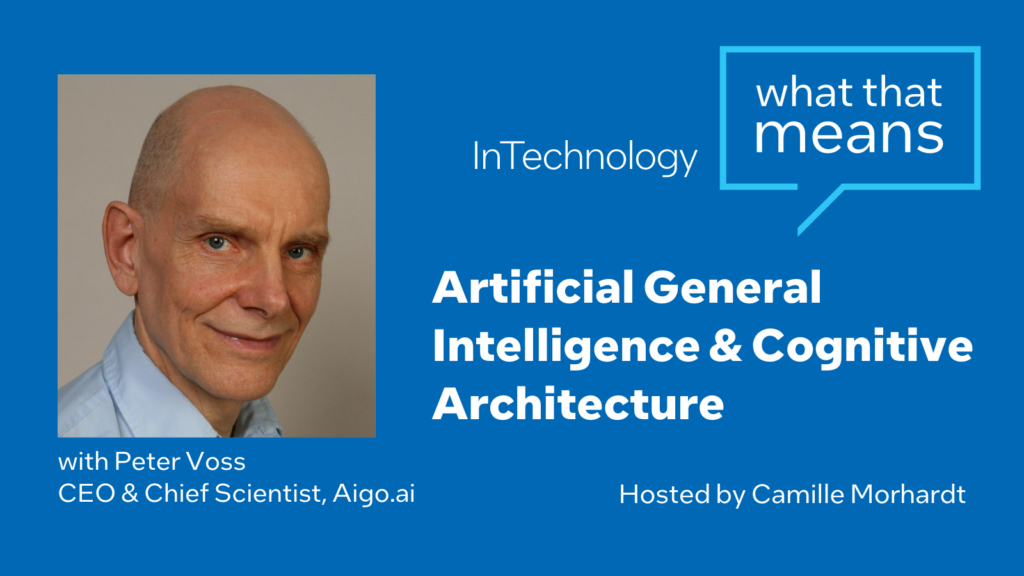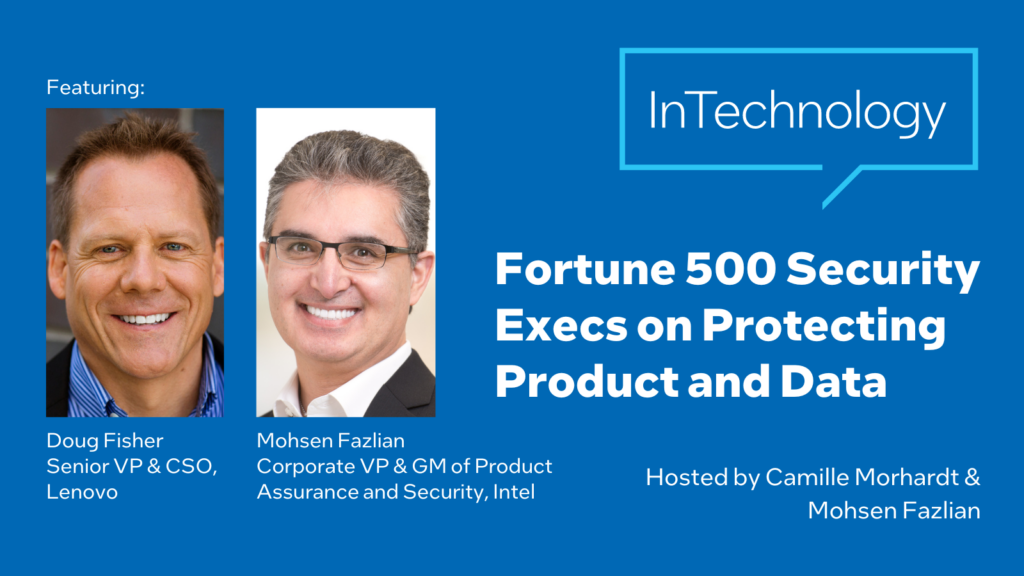Peter Schelstraete 00:11
Sustainability still now sits in the hands of a few people inside companies. What’s so amazing about large language models is that all of a sudden, you can just ask questions, and you become much smarter on sustainability, much more immediately.
Camille Morhardt 00:28
I’m Camille Morhardt. And today’s podcast is with Peter Schelstraete who’s joining us all the way from Amsterdam. Peter is actually a former Vice President at Coca-Cola. And he worked there for almost two decades, and then quit and started a company called Ubuntoo, which actually works on helping corporations become more sustainable. And they’ve just launched Ubuntoo AI, which is based on large language models. So we’re going to talk to him about environmental solutions platform and pitfalls and examples there. Welcome to the podcast, Peter.
Peter Schelstraete 01:04
Thanks for having me. Camille.
Camille Morhardt 01:06
I’m very interested to know using AI to do this large language models, really interested personally in this intersection between AI and sustainability. And I have, you know, always like a bit of one skeptical eyebrow with the whole thing, too. So I’m interested in how it works.
Peter Schelstraete 1:23
So do I, absolutely.
Camille Morhardt 01:26
I guess first, just tell me what the company does and what it’s based on. And then we can find out why you stopped. Your personal story.
Peter Schelstraete 01:35
Yeah, the two are linked to each other. Ubuntoo is an environmental solution platform. Essentially what we do we use collective intelligence to give exponentially better access and faster access to environmental solutions and knowledge. And collective intelligence in our world is the combination of artificial intelligence and human curation, or human experts. And we tend to say that the human experts–especially when you talk about sustainability–still need to be in the driver’s seat. But in today’s world, it’s very important that companies that want to do good, that want to achieve something, that they can do so effortlessly.
Camille Morhardt 02:16
You were thinking this six years ago? I mean, this seems very early to me.
Peter Schelstraete 02:21
Yes, well, AI was existing. Back in the days I was Global VP of Digital at Coca-Cola. So I was really aware of all the digital technologies that were emerging. So we were always talking about IoT, about AI in general, not so much large language models. But what’s striking me is that solutions were not evenly distributed; it was very, very hard to find solutions, hard to find the right knowledge, and especially practical knowledge around sustainability is very hard to find. You probably know that it’s easy to find academic articles because there’s search engines for it. But practical knowledge is much tougher. And our learnings from Coca Cola led us to believe that it’s really not practical knowledge, the best practices that really matter. Right? If you find best practice, how can you scale it? If you find the technology, how can you scale it at a much faster pace than what we used to? In Coca Cola was also part of the global team. And that’s exactly what we did is we look for best practices around the world and say, “well, this could work from China, it could work also in Australia could work in the US,” and scale it as much as possible. And that’s actually also where we’re trying to do right now.
Camille Morhardt 03:34
Why did you pick sustainability? I mean, you weren’t working in sustainability when you were at Coca- Cola, that wasn’t your focus. So, you took the transferable skill of scaling, and your knowledge in the digital world to the company that you founded. But why did you focus on sustainability?
Peter Schelstraete 03:51
First of all, it’s a personal passion of mine, has always been. Sometimes I tell the story about the two Smoky Mountains. I used to live in Atlanta, beautiful mountains, pristine, clean nature; but I also lived in the Philippines in Manila. And close to the Manila, there’s the Smoky Mountains, which is basically a massive dump site, where hundreds of families live and they work in the dump site, also including the kids. It’s a whole different world. And I was exposed, whether it was in Africa or Southeast Asia, even in some cases the US actually, to a lot of environmental problems. And the environmental problems really reach, unfortunately, the less fortunate of the society first, right.
And so it’s a personal passion of mine, but also, at the same time, also a business person and sustainability is a business opportunity. And it should be if you’re really planning to scale sustainable solutions it needs to be driven by a sustainable business also. And so the combination of in the beginning when I left Coca-Cola, I said “well, it’s a career to calling.” In a way you should think about as a career and a calling, not just a career or a calling. And that’s how I see what we’re doing a window.
Camille Morhardt 05:08
That makes sense. So tell me more, how does your solution work?
Peter Schelstraete 05:12
There’s the overall Ubuntoo approach. And that’s Ubuntoo AI. And I’ll talk about Ubuntoo AI in a minute. Let’s say a company comes to us and say “we have 300,000 tonnes of agave waste, and we want to know what to do with it. What can we do with it?” But also is a maybe a business model behind it? So what we do in this case, we would look at more than a billion data points with AI engines. We look at technologies, IP filings, articles, you name it, right, so we do a complete landscape. And then we have human curator, human expert that basically looks at what are the more interesting solutions for this company? How can we also do matchmaking with this company? And let’s say we find 1000 solutions, we all the way to what are the top three to five solutions and companies and startups that they need to be working with? Now, that takes generally about six to eight weeks, sometimes a little bit more—that whole process. So we were thinking, if you do this over and over again, you’re building actually quite an impressive database of solutions. And we’ve been on this for more than five years, so we have a database of 8,000 solutions. 25,000 knowledge posts, very, very interesting.
And then, in the course of the last, let’s say, 18 months came a gift from heaven for us, which is the large language models that made it so much easier for us to understand our own database; because we didn’t understand our own database anymore. It was too big. And so then we created Ubuntoo AI. Essentially, it’s like a Chat GPT for the environment. But unlike GPT, it really mines our own database, it looks at our own database, because it’s a curated database. It’s been reviewed by experts. We’ve been working on this for five years. And so all of a sudden a process that normally a company would create a briefing. “Hey, we have this issue,” brief a couple of agencies consultancies, for example, can you find a solution, and that easily takes three to five months or six months, sometimes, all of a sudden, I would say that 80% of that whole process, you can do in a couple of seconds. And that’s the future of what we’re doing really is the future of use of large language models, is really exponentially increasing the speed, but also the quality of the answers you get, of course, for that you need a database that is extremely powerful.
Camille Morhardt 07:43
So what is in your Ubuntoo AI? Is it all public information that based on prior searches from like the internet? Or do you have company IP as to what they’re solving and how they’re solving it?
Peter Schelstraete 07:57
It’s based on the prior research that we did. So essentially, where we did this, so we started by way, five years ago with focus on plastic pollution, recycling, packaging, because we were, you know, ex-Coca-Cola–was very, very hot topic for Coca-Cola also. And then we gradually moved into regenerative agriculture, for example, healthy oceans; we started working for more and more companies, but also for organizations like UNDP, IUCN, UNEP. So these important institutional companies and also more and more academic institutions.
What is in the database, to come back to your question is, in essence, publicly available information, most part. And so the beauty of it is not really in, you know, could you find it, essentially, you could, if you use AI engines, search engines, and what have you. The beauty sits in the curation of it, and making sure that whatever you see is really reviewed already by some of the experts. And that is very, very important. That’s why we like working with these institutions and academic institutions.
So for example, we are working on a project right now that we kicked off on food safety and Africa. It’s a four-year project, looking at the how can we get away from pesticides, for example, in the food chain in Africa. Now, our partners, academic institutions and research institutions, who are really experts in this field. And so they help us looking at data, looking at solutions, looking at knowledge posts, and they’re the ones helping us to select what are the best. And so the quality of that database becomes extremely, extremely important.
The reason why we are so focused on the quality of the database in a way more than large language model is because as you very well know, any hypothesis can be proven true by Googling. And it’s exact opposite can be proved by Googling also. And so that’s a very dangerous situation, especially when you work on topics like food safety, or climate change. For example, which is really, really important issues for the world. And that’s why we really, really focus on the quality of the database.
Camille Morhardt 10:07
I assume when you if you’re a company and you’re trying to implement one of these changes, you’d like to know what’s the lowest hanging fruit or the biggest bang for the buck, or how realistic or how long it’s going to take to implement various things, how much it costs. Are those kinds of things something that you can help with on sort of individualized or customized basis?
Peter Schelstraete 10:28
Certainly on customized basis, but even using Ubuntoo AI. So for example, one of the elements that we’re using, as we describe solutions is TRL Level. TRL Level is technology readiness level, it’s a scale from 1 to 9, and 9 is fully in market. But 1, for example, is just an idea. And then you do research. And then you do prototype, but 9 is fully in market and 8 is scale up. And oftentimes a company would come to us and say, “Well, you know, we really only interested in 8 or 9” or “we really want to know the future of the technology, so we’re interested in 5 and 6,” for example. And so this is something that we can integrate also in a large language model in the text and say, “Well, you know, give me solutions that only are completely readily available right now. Or maybe a solution that is, is going to be ready in two, three years from now.”
Camille Morhardt 11:21
And do you have any examples that you could share?
Peter Schelstraete 11:26
Yeah, so just a couple of projects, for example, that we’ve been working on, with a fashion company, making sneakers–very well-known brand in sneakers. We looked at biobased materials for sneakers. So could you use, for example, mango waste, and use them as the upper of your sneaker? Which is possible. Could you do something with pineapple waste, and convert it into textile? Could you have ink for your sneakers that is made from carbon capture? So all of this is based on actual prototypes that were developed. And based on the search that we did, and we found extremely interesting, actually, more than 400 solutions in this space.
There’s so many innovators around the world working on these topics. But it goes also into very technical things, right? So we have a company we work with has massive amount of pineapple plantations in the Philippines. And the question that sometimes comes, as well, how can we move away from pesticides? What are the alternatives? How can we move towards regenerative agriculture? And this might be a little bit less sexy, but very important, nevertheless.
Especially what is interesting and important. I think also, with large language models and AI utilization of AI, that sustainability still now sits in the hands of a few people inside companies, or inside these organizations. It’s very hard to be good at it, because you need to really dig in into it. But so amazing about language models, and we see that with Ubuntoo AI is that all of a sudden, you can just ask questions, and even the stupid questions. Specialist would say, well, you should know this. No, just ask away. And you increase your capabilities, we have one company that has more than 2000 people using it. And it’s not necessarily just from specialists already working on sustainably, it’s actually becoming more mainstream, and you become much smarter on sustainability much more immediately, which is amazing.
Camille Morhardt 13:30
I want to talk a little more about this organizational problem, because when you have like a division or a person within a company that’s responsible for sustainability, but they’re not really responsible for product, they’ve got to negotiate, I suppose, with the product team to try to make a change. And I’m assuming when you’re going from switching an entire manufacturing process or supplier, all the rest of it, I mean, there’s a huge cost and time investment with that. So how does the world kind of move forward with those constraints?
Peter Schelstraete 14:03
Yeah, very good question. I compare sustainable, you know, to where digital was 20 years ago, in corporations, I mean. Digital was new, everyone was shooting from the hip. It was tech rush and it was not integrated. There was pockets of excellence, but it’s set in a couple of divisions, couple of hands heads. But it was not really well distributed. And this is typically what we see with sustainably right now. Also, it’s amazing to see in companies how many people really want to drive sustainable lead to good things, especially the young people. But it’s oftentimes really little bits here and there and left side of the organization doesn’t talk to the right side. Ultimately, at the very core of that issue is the fact that sustainability oftentimes is not being seen as a value driver, as a growth driver. All too often, sustainably is being seen as the cost to the business. Some things you have to do, because you know of legislation, especially in Europe, you see that happening. And that’s why it’s not been really, really integrated yet, that we see. And so the more you can integrate it, the more you can make it central to the growth strategy of a corporation, capture value, right, because a lot of value to be captured to sustainably either in a value chain less supply chain, converting waste into something valuable making money out of it.
But also, how can you communicate sustainability in a credible way, and a powerful way towards consumer so you have a pricing power? And that is at the very essence of the struggle that a lot of companies have right now, where again, the inspiration of having access to solution, the inspiration of knowing that there’s best practices out there in the world–it has worked, it can work–is so important, and make that accessible throughout the organization.
Camille Morhardt 15:57
And you talked about back when you’re in Coca-Cola, kind of taking a best practice from one area of the world and then looking at commonalities elsewhere, and maybe applying a similar kind of a practice. When a company is looking at, I’ll say a global company, is looking at trying to improve sustainability practices, do you think that it should look at sort of practices that go across the entire company? Or do you think that companies are better served by kind of more of a grassroots or a distributed approach to sort of grounds up in various locations–like you may be dealing with water waste or management in one area and something completely different in another part of the world?
Peter Schelstraete 16:36
Well, I think first of all, companies are better off to look outside their own organization first. And really understanding landscape of what is existing? What is possible out there? Because there’s only so much you can do purely internally. And a good example of that is waste. A good waste system is never really dependent on one company; it actually should not be dependent on one company, it’s really organized, obviously, oftentimes, governmentally organized or privately organized. But also even the best practices, because you ask yourself, if you’re working on an issue, that is an issue for your company, most likely, there’s other companies that have been working on it also.
And every time we do kind of landscape of best practices, it’s amazing what comes up that other people have been trying to think of, or that technologies or startups have been trying to figure out. And so that I would say the first thing to do is to do a kind of a landscape. We use the double diamond approach, which is understand who’s doing what, what did we learn so far? What are the best practices? And then say, “well, you know, based on all of the learnings, here’s exactly what we want to solve” and then search for the partners.
Camille Morhardt 17:48
And how do people protect their IP?
Peter Schelstraete 17:53
Well, oftentimes, that’s where the rubber hits the road. And there’s a danger, especially if you’re a big company, and there’s new technology, because then they say, “Wow, this is interesting” and all of a sudden, this massive machinery of the big company with the legal people and the technical people come in, and R&D people, and it’s just overwhelming small organizations to say, “well, you should I do this and that and that”. So it’s not just IP, it’s also overwhelming weight of having to deal with a big company.
The IP in general could be protected, I’d say, by a technology provider, in, let’s say, the agreement. And then also say, well, that the best way to protect your IP is speed, you need to be quicker, and agile.
Camille Morhardt 18:40
Very interesting. What else should I be asking you about this topic?
Peter Schelstraete 18:47
One of the topics that we haven’t discussed enough–especially with the rise of large language models–is what kind of knowledge do we need to solve our most pressing issues? There’s massive gaps in terms of diversity of knowledge, in terms of practicality of knowledge, and again, I’m talking about the AI engines that tend to be based on search, and search of databases. The database that exists tend to be more academic in nature, or tend to be we have database of companies. We have databases of startups; we have databases of academic articles. Very easy. Do have databases of best practices of farmers, on regenerative agriculture? No. The practicality of human knowledge that has been amassed over the decades–centuries sometimes—is oftentimes not written down.
Camille Morhardt 19:39
Isn’t that largely for IP reasons, though? I mean, why, why is that?
Peter Schelstraete 19:43
First of all, oftentimes, they sit in organizations that don’t publish–and they also don’t publish because that’s the second issue is a lack of diversity in knowledge, because more than 95% of academic articles are English language. Now, if you have the best practice of Ivory Coast, for example, of some regenerative farming, we will talk about the last year pineapple farming in Ivory Coast, these learnings were written down in French, never been published. And so you have so many organizations that have all this knowledge in local languages, also, oftentimes, never published that is just sitting there, and not accessible to anyone. And so if you think about the need for practical knowledge, the need for some kind of diversity and knowledge, we have a long way to go. We’re just scratching the surface; even with the best language models, we’re not able to capture them. And so this is ultimately what we’re trying to do is unearth, topic by topic, what are these practical pieces of the gems of you know, “if you do this, this is what’s going to happen.” And that is going to take a massive effort, specifically on sustainability to really give it some kind of visibility.
Camille Morhardt 21:02
What do you think can be done?
Peter Schelstraete 21:04
Open protocols for knowledge sharing? Definitely. And also, how to incentivize organizations to share the knowledge. If we have a network of databases with a revenue model that makes it interesting for those that are generating knowledge to also capture some of the revenue of it, that will be absolutely fantastic. And then they can invest also in making sure that it’s, it’s accessible. And right now, we don’t have that. And I see too many cases where an organization say of “oh, talk to that person, talk to that person.” And then you know, months later, we’re still nowhere.
So we just had the very start of this journey and it’s daunting; but yeah, it’s exciting at the same time.
Camille Morhardt 21:49
Peter Schelstraete, from Ubuntoo, environmental solutions platform. Thank you very much for joining today.
Peter Schelstraete 21:56
Thank you, Camille, it was a real pleasure talking to you.
Camille Morhardt 21:58
All the way from Amsterdam. Yay technology!
Peter Schelstraete 22:00
Exactly. (laughs)




